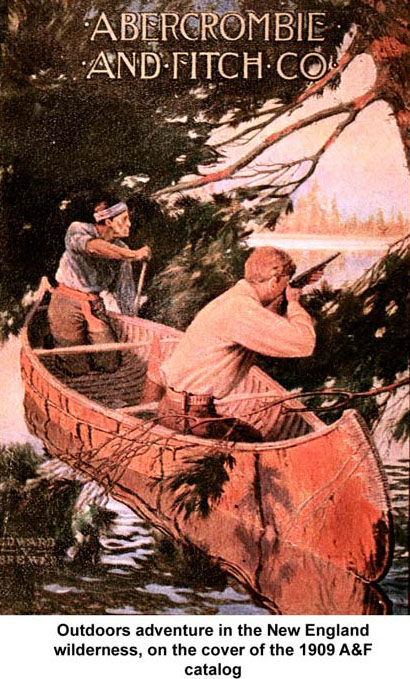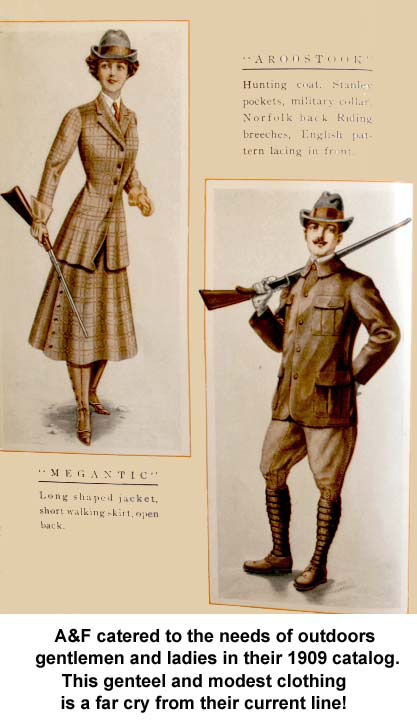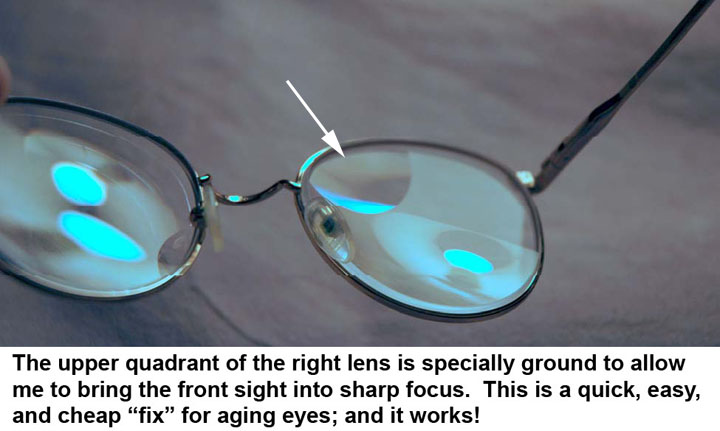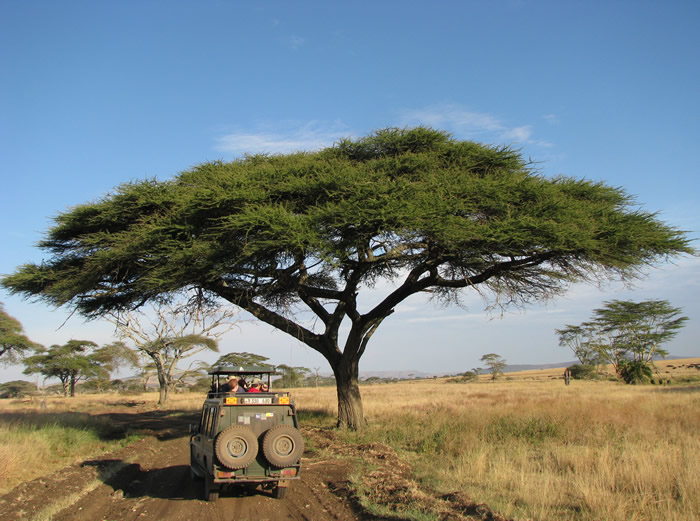DOUBLE TROUBLE
This essay originally appeared in Magnum magazine, a sporting journal published in South Africa
One class of firearm more than any other evokes the
romance and mystery of hunting the Dark Continent:
the double rifle. Early in my life I was captivated by
the romance of Africa and the idea of hunting there.
Inevitably, I developed a yearning for one of these
iconic weapons, even though as a kid growing up in
New York City it seemed more likely that I would
travel to Mars than Africa.
 In those long-dead days New York City was the
home of the greatest outfitter in the world, the
upscale department store, Abercrombie and Fitch. It
surprises some today to realize that A&F wasn’t
always a clothing store for nubile teenagers. The real A&F was to New York what Harrod’s is to London:
and it was the place to get kitted out for your safari.
In those long-dead days New York City was the
home of the greatest outfitter in the world, the
upscale department store, Abercrombie and Fitch. It
surprises some today to realize that A&F wasn’t
always a clothing store for nubile teenagers. The real A&F was to New York what Harrod’s is to London:
and it was the place to get kitted out for your safari.
While everything
needed for a normal
upper-crust life was
sold in their 5th
Avenue building,
A&F was most
famous for The Holy
of Holies, the
veritable Mecca of hunting gear, the Gun Room. Here were
displayed any number of very expensive firearms, new and
used—used by the likes of Maharajahs and Princes, no less—
including many double rifles. In its heyday A&F served the
needs of such hunting luminaries as Earnest Hemingway, Robert
Ruark, Robert Stack, and yes, Teddy Roosevelt, whose gear for
his famous 1909 safari was supplied by them.
Not only did A&F
carry the finest of guns, they also stocked the finest leather goods, accessories, and ammunition to go with them.
Needless to say, an awestruck 14-year-old wasn’t allowed to
touch any of this stuff, but the aroma of high-grade leather and expensive gun oil, combined with the muted visual elegance of
cased Purdeys and H&H double guns drew me back again  and again to worship at The Shrine. I
vowed that someday, God willing, I was going to own a double rifle, some kind of double rifle,
though I probably could never aspire to one of those fantastic examples of the gunmaker’s art
that A&F had on offer.
and again to worship at The Shrine. I
vowed that someday, God willing, I was going to own a double rifle, some kind of double rifle,
though I probably could never aspire to one of those fantastic examples of the gunmaker’s art
that A&F had on offer.
In time, I left New York, the real A&F closed its doors, and I gained age, experience, income,
and girth; but I never completely lost my hankering for a double rifle. Unfortunately it also
happened that the prices of these guns steadily marched upwards faster than my income; the gap
between what I wanted and what I could afford never seemed to narrow. Eventually the dream
of someday owning a double rifle was more or less laid aside in favor of more affordable and
practical equipment. Then, too, until not so very long ago the biggest thing I was ever likely to
hunt was a whitetail deer, and nobody needs a double rifle for one of those. Then along came
Davide Pedersoli, to re-awaken the dormant desire.
I’m a very experienced black powder hunter. I don’t hunt with muzzle-loaders exclusively, but I
own a number of them and have used them successfully in North America and in Africa; the
truth is I probably take more game with muzzle-loaders than with modern firearms. That’s why,
when I found out that Pedersoli was selling muzzle-loading double rifles I had to take a long and
hard look. I held out manfully for a while, but when they announced their .72 caliber “Kodiak
Express” just about the time I received a small windfall, I could no longer resist. I shelled out
what amounted to the price of perhaps four boxes of .500/.450 Nitro Express ammunition—and
that bought me a beautiful, shiny-new muzzle-loading Pedersoli Kodiak. I had my double rifle, at last.

There was, though, one very real issue with this gun, and it wasn’t that it loaded from the front. It
was that I couldn’t hit anything with it.
I religiously followed the instructions and the load
recommendations that Pedersoli provided, but I found my shooting with it inconsistent at best.
One day I’d take it to the range and do fairly well; the next session, using the same loads, the gun
was shooting wildly all over the map. No sooner than I would semi-convince myself that I had
the right-hand barrel sighted in than the left barrel would be shooting into the next county.
The
Kodiak has two open sights, and I assumed that it was because of the presence of two barrels. You get what you
pay for and the time and effort to regulate barrels to hit the same point of aim is a major part of the price of a double rifle.
For what I paid Pedersoli couldn’t have done the same job H&H would, so I assumed (incorrectly as it transpired) that they'd taken the less expensive step of providing a sight for each barrel.
I’m not one to blame the tool for the workman’s shortcomings, and I vowed I would learn
how to use that beautiful gun, come what might. I desperately wanted to hunt with it. After a
summer of practice I felt confident enough at least to take it into the woods for deer, as our
ranges are very short thanks to thick cover. Nevertheless, the first time I fired it at game, a small
whitetail buck not 40 yards away, just at dusk, I missed him completely. I had all kinds of
reasons to explain that poor shot: the light was bad, I couldn’t really make out the sights, chalk
that one up to experience, try again next year.
Later I took it to a place where one can shoot feral hogs. Two pigs ran past me all of 20 yards
away, and I missed the one I shot at, this time with both barrels. That was inexplicable: I’m not
that bad a shot that I could miss a whole pig at 20 yards! I was infuriated to the point where I
seriously thought about selling it, but I decided the issue was…..aha! the gun didn’t fit me. I have
short arms and perhaps getting the stock shortened would help. Off to the gunsmith it went.
When it came back I shot it as badly as ever.

Now, a problem we Gentlemen Of A Certain Age have is that as we get older our eyes become
less and less suited to open sights. The secret to shooting well, we are always told, is to
“concentrate on the front sight, make sure it’s in focus, ignore everything else,” but when Time
has robbed you of the ability even to see the front sight except as a blurry and ill-defined gold-colored
fuzz-ball, this advice is pretty useless. Even the rear sight isn’t well-defined with eyes
like mine. I had to conclude that for me, the Kodiak’s sights were worthless appendages. I blush
to admit that I briefly toyed with the idea of a scope or a red dot sight, but my better nature won
out and I swear, I never committed the sacrilegious act of putting optical sights on a double rifle.
Assuming my theory about the sights was correct, the only solution seemed to be to find a way to
see the front sight clearly. I tried one of those iris diaphragm gadgets used by bulls-eye target
shooters. Closing the iris diaphragm enhances what a photographer calls “depth of field,” and in
fact it did improve my ability to make out the bead a bit. But it was a bunglesome affair that
adhered to the lens of my eyeglasses using a rubber suction cup. For target work on a range it
might be useful but in the hunting field it wouldn’t have worked and might even have been
dangerous if fast shooting were called for. In dim light it would be totally worthless.
I was pretty despairing at that point. I had arranged a safari in Namibia and had hoped to bring
the double, but the miserable and unreliable shooting I was doing with it put that idea right out of
my head. The prospect of attempting a shot and missing—or worse, wounding—something like
an eland deterred me. I left the double at home and brought a different muzzle-loader, one in
which I had complete confidence (and with which I killed a nice warthog).
I was bemoaning my fate to a friend, who mentioned an article he’d found in a 40+ year old issue
of The American Rifleman magazine. It described how an optician could make a me set of
eyeglasses specifically for use with open sights. I wear progressive bifocals, but one lens of
these could be replaced with a new lens: it could be ground with a segment specifically designed to
bring into sharp focus objects about three feet away…such as gun sights.
I had one of these
lenses made on a spare pair of glasses, and it works : the special segment is positioned so that
when my head is lowered I look through it; the rest of the lens is set up for normal distance
vision. Finally, I could see the front sight clearly.
About this same time I attended a firearms trade show. There I saw another Pedersoli product,
their “Gibbs African Hunter” a single-shot .72 caliber muzzle-loader. I was particularly taken by
the Gibbs’ rear sight: a “ghost ring” peep sight set into the tang. The African Hunter handled beautifully,
coming up to my shoulder naturally, but it was the sighting system that really intrigued me. It looked like the answer to this
frustrated double shooter’s prayer, if I could get something like it mounted on my double.

I asked, and Pedersoli’s representative told me that, yes, the Gibbs sight could be ordered as a spare part. To
my eye it looked like the curvature of the tang on both rifles was “close enough.” I ordered the
sight. My local gunsmith made some minor changes in the sight base, and I brought home my
Kodiak with a peep sight on the tang.
The proof of the rifle is in the shooting, so with the new sight in place I hied myself off to the range and tried again. This
time, I swore that if I still couldn’t hit anything reliably, the rifle was going up for sale, and
romance be damned. Initial results were, well, not disappointing, but not overwhelmingly
superior, at least in terms of consistent point of impact. But, as I said, I’m a very experienced muzzle-loader shooter and I’ve learned the hard way that
every muzzle-loading rifle—every muzzle-loading rifle barrel—is a law unto itself. You have to
learn each one’s quirks and preferences to get the most out of it. So it proved this time.
I approached the next range session with a firm intention to get the right barrel sighted in and not to
shoot the left barrel at all until I had accomplished that much. The argument I made was that
first shot is the one that matters most. If I could be reasonably certain of hitting my target with
the right barrel, then whatever the left barrel did was far less important. Since Pedersoli installs two adjustable open rear sights on this rifle I was assuming that the regulation wouldn’t be all that great.
The new glasses
allowed me to see the front sight clearly, although the target paper was somewhat fuzzy. However, I
was shooting for “center of mass” and decided not to worry about it. So long as I could get the
gun to group consistently I’d be okay.
Pedersoli had specified a load, so I stuck with it at first…and found the right barrel shooting inconsistently
still.
I put my black-powder-shooter hat back on and thought a bit on why a muzzle-loader
sometimes shoots poorly.
One reason is that black powder is very dirty stuff and fouling is a real issue. Especially in large
bore rifles, which tend to have very shallow rifling, there isn’t much space for the crud to go, and
after a few shots the ball fits too tightly and pressures are inconsistent. That was the case with
this gun: it has very shallow rifling that became filled with fouling to the point where it was difficult to
reload after only two shots. The only cure for this is to swab the barrel out, a common situation
with muzzle-loaders. Using this as a starting point for my next try, I concluded
that since the first shot came out of a clean barrel, it would be unreasonable to expect subsequent
ones from a dirty barrel to hit the same point of impact. That was the trick. Swabbing between each shot returned the barrel to its original status and
immediately things settled down and groups started consistently hitting in the same place.
Finally I could start adjusting the sights to bring the point of impact where I wanted it.
My groups were high and to the right at the initial sight-in distance of 50 yards. Putting the
ghost ring as far down as it would go and shifting it to the left brought the group to the vertical
center, but it was still very high. Since I couldn't put the rear sight any further down, there was only one option left to lower the point of impact: reduce
the powder charge. A reduction from 90 grains of FFg to 80 immediately brought the center of
each group down to about 5 inches above point of aim using the right barrel. Once I had this
information I managed to ring a six-inch gong consistently by holding at its lower edge.
It was time to shoot that left barrel and see where it put a bullet. Lo and behold, the left barrel
shot almost exactly to the same point as the right one did at 50 yards, being a smidgen to the left!
That was an entirely unexpected result, but very welcome. Regulating a double rifle is a fiendishly
expensive exercise, and in “best guns” is done by actual trial-and-error, but Pedersoli clearly
isn’t doing it that way. How they do it I don’t know—with lasers, maybe?—but whatever they do, works.
 I can’t imagine shooting any rifle with iron sights at a game animal more than 100 yards away so
I set the target back to give it a try at that range. To my amazement, the bullets from the right
barrel hit the point of aim, dead on…and those from the left barrel only an inch or so to the right of them. I concluded that Pedersoli regulated the barrels to hit the same POI at about 75-80
yards. By the time bullets reach 100 yards the trajectories have “crossed over.”
I can’t imagine shooting any rifle with iron sights at a game animal more than 100 yards away so
I set the target back to give it a try at that range. To my amazement, the bullets from the right
barrel hit the point of aim, dead on…and those from the left barrel only an inch or so to the right of them. I concluded that Pedersoli regulated the barrels to hit the same POI at about 75-80
yards. By the time bullets reach 100 yards the trajectories have “crossed over.”
The trajectory of a slow moving round ball is like that of a baseball, which accounts for the very
high strike at 50 yards. A 0.715” round ball weighing 535 grains has a “ballistic coefficient” of
0.098: assuming an initial velocity of 1400 feet per second, and a zero distance of 100 yards, a
bit of number crunching in ballistics software gives a mid-range trajectory of…5.1 inches! Close
enough! No double rifle is expected to shoot minute of angle and this one certainly doesn’t, but I
am now far more confident than ever before that I can actually use it effectively.
Double rifles, like beautiful women, will break your heart; but if either decides to cooperate, the time and
effort expended to make it happen is well worth it. Maybe, just maybe, I will take this double on
safari yet.
Addendum, January 10, 2021: Gone To A Good Home
The beautiful Pedersoli double rifle will never be taken on a safari, at least not by me. It has been sold, through an ad in Muzzle Blasts magazine, a periodical for black powder shooters. I hated to let it go and I took a financial beating on it, but I can't use it in Virginia's black powder season (only single shots are allowed) and the odds of my going back to Namibia are somethere between slim and none. The new owner plans to take a feral pig with it. I hope he does and wish him waidmannsheil.
 In those long-dead days New York City was the
home of the greatest outfitter in the world, the
upscale department store, Abercrombie and Fitch. It
surprises some today to realize that A&F wasn’t
always a clothing store for nubile teenagers. The real A&F was to New York what Harrod’s is to London:
and it was the place to get kitted out for your safari.
In those long-dead days New York City was the
home of the greatest outfitter in the world, the
upscale department store, Abercrombie and Fitch. It
surprises some today to realize that A&F wasn’t
always a clothing store for nubile teenagers. The real A&F was to New York what Harrod’s is to London:
and it was the place to get kitted out for your safari.  and again to worship at The Shrine. I
vowed that someday, God willing, I was going to own a double rifle, some kind of double rifle,
though I probably could never aspire to one of those fantastic examples of the gunmaker’s art
that A&F had on offer.
and again to worship at The Shrine. I
vowed that someday, God willing, I was going to own a double rifle, some kind of double rifle,
though I probably could never aspire to one of those fantastic examples of the gunmaker’s art
that A&F had on offer.


 I can’t imagine shooting any rifle with iron sights at a game animal more than 100 yards away so
I set the target back to give it a try at that range. To my amazement, the bullets from the right
barrel hit the point of aim, dead on…and those from the left barrel only an inch or so to the right of them. I concluded that Pedersoli regulated the barrels to hit the same POI at about 75-80
yards. By the time bullets reach 100 yards the trajectories have “crossed over.”
I can’t imagine shooting any rifle with iron sights at a game animal more than 100 yards away so
I set the target back to give it a try at that range. To my amazement, the bullets from the right
barrel hit the point of aim, dead on…and those from the left barrel only an inch or so to the right of them. I concluded that Pedersoli regulated the barrels to hit the same POI at about 75-80
yards. By the time bullets reach 100 yards the trajectories have “crossed over.”